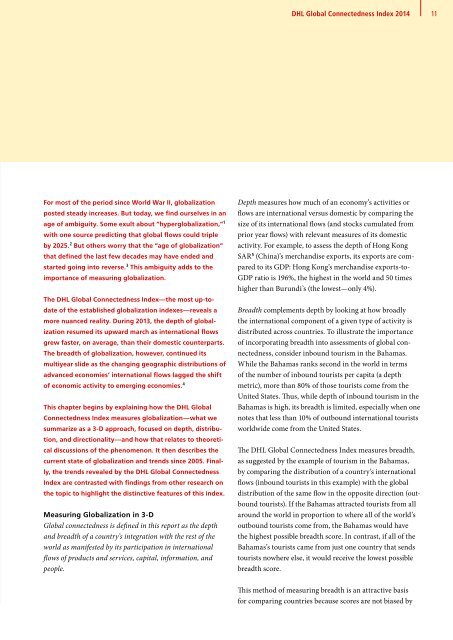DHL Global Connectedness Index 2014
DHL Global Connectedness Index 2014
DHL Global Connectedness Index 2014
- No tags were found...
Create successful ePaper yourself
Turn your PDF publications into a flip-book with our unique Google optimized e-Paper software.
<strong>DHL</strong> <strong>Global</strong> <strong>Connectedness</strong> <strong>Index</strong> <strong>2014</strong><br />
11<br />
For most of the period since World War II, globalization<br />
posted steady increases. But today, we find ourselves in an<br />
age of ambiguity. Some exult about “hyperglobalization,” 1<br />
with one source predicting that global flows could triple<br />
by 2025. 2 But others worry that the “age of globalization”<br />
that defined the last few decades may have ended and<br />
started going into reverse. 3 This ambiguity adds to the<br />
importance of measuring globalization.<br />
The <strong>DHL</strong> <strong>Global</strong> <strong>Connectedness</strong> <strong>Index</strong>—the most up-todate<br />
of the established globalization indexes—reveals a<br />
more nuanced reality. During 2013, the depth of globalization<br />
resumed its upward march as international flows<br />
grew faster, on average, than their domestic counterparts.<br />
The breadth of globalization, however, continued its<br />
multiyear slide as the changing geographic distributions of<br />
advanced economies’ international flows lagged the shift<br />
of economic activity to emerging economies. 4<br />
This chapter begins by explaining how the <strong>DHL</strong> <strong>Global</strong><br />
<strong>Connectedness</strong> <strong>Index</strong> measures globalization—what we<br />
summarize as a 3-D approach, focused on depth, distribution,<br />
and directionality—and how that relates to theoretical<br />
discussions of the phenomenon. It then describes the<br />
current state of globalization and trends since 2005. Finally,<br />
the trends revealed by the <strong>DHL</strong> <strong>Global</strong> <strong>Connectedness</strong><br />
<strong>Index</strong> are contrasted with findings from other research on<br />
the topic to highlight the distinctive features of this index.<br />
Measuring <strong>Global</strong>ization in 3-D<br />
<strong>Global</strong> connectedness is defined in this report as the depth<br />
and breadth of a country’s integration with the rest of the<br />
world as manifested by its participation in international<br />
flows of products and services, capital, information, and<br />
people.<br />
Depth measures how much of an economy’s activities or<br />
flows are international versus domestic by comparing the<br />
size of its international flows (and stocks cumulated from<br />
prior year flows) with relevant measures of its domestic<br />
activity. For example, to assess the depth of Hong Kong<br />
SAR 5 (China)’s merchandise exports, its exports are compared<br />
to its GDP: Hong Kong’s merchandise exports-to-<br />
GDP ratio is 196%, the highest in the world and 50 times<br />
higher than Burundi’s (the lowest—only 4%).<br />
Breadth complements depth by looking at how broadly<br />
the international component of a given type of activity is<br />
distributed across countries. To illustrate the importance<br />
of incorporating breadth into assessments of global connectedness,<br />
consider inbound tourism in the Bahamas.<br />
While the Bahamas ranks second in the world in terms<br />
of the number of inbound tourists per capita (a depth<br />
metric), more than 80% of those tourists come from the<br />
United States. Thus, while depth of inbound tourism in the<br />
Bahamas is high, its breadth is limited, especially when one<br />
notes that less than 10% of outbound international tourists<br />
worldwide come from the United States.<br />
The <strong>DHL</strong> <strong>Global</strong> <strong>Connectedness</strong> <strong>Index</strong> measures breadth,<br />
as suggested by the example of tourism in the Bahamas,<br />
by comparing the distribution of a country’s international<br />
flows (inbound tourists in this example) with the global<br />
distribution of the same flow in the opposite direction (outbound<br />
tourists). If the Bahamas attracted tourists from all<br />
around the world in proportion to where all of the world’s<br />
outbound tourists come from, the Bahamas would have<br />
the highest possible breadth score. In contrast, if all of the<br />
Bahamas’s tourists came from just one country that sends<br />
tourists nowhere else, it would receive the lowest possible<br />
breadth score.<br />
This method of measuring breadth is an attractive basis<br />
for comparing countries because scores are not biased by





